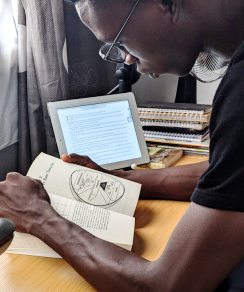As part of the Pathways Collaborative, OCCRL hosted a webinar on July 15 titled “Assessing and Advancing Equity Through Guided Pathways,” the second one in a July series. It was led by Maggie Fay, John Fink, Davis Jenkins, and Hana Lahr, all research associates at the Community College Research Center (CCRC).
The webinar focused on identifying equity gaps in community colleges for historically marginalized student groups and addressed current policies and practices that inherently reduce the likelihood of positive student outcomes. With assistance from the OCCRL Pathways Collaborative Equity Partners Fund and the Bill and Melissa Gates Foundation, CCRC has developed a data tool and planning tool that better equip institutions to assess and respond to equitable access, progress, and success.
Fink began the presentation by discussing the underlying research that spawned the tools’ development. He began by asking those in attendance to think about defining success and bridging equity gaps in access to college, degree completion, and post-graduation success. His institution’s findings have revealed that closing the equity gap early in these key indicators of progress is an important strategy to promote faster and longer-lasting success.
Research showed that while the prevalence of various pathways in community college programs can result in a wide range of economic opportunity, they also produce inequitable outcomes for certain groups.
Improving in these areas is especially important in community colleges. Research showed that while the prevalence of various pathways in community college programs can result in a wide range of economic opportunity, they also produce inequitable outcomes for certain groups such as African American and Latino students.
“In the community colleges, it’s pronounced because there’s not only the fields of study, but you’re looking at general liberal arts, STEM, manufacturing, or construction. There’s also the credentials—long-term certificates, associate’s degrees, transfer, bachelor’s degrees, and graduate degrees,” Fink said.
Advancing equity within the realms of these indicators goes hand in hand with the Guided Pathways program, which involves assessing equity at the program level, according to Fink. While completing their research, he and his colleagues came up with several questions that are important for institutions to evaluate and respond to when it comes to equity and inequity in their programs: Which programs don’t advance opportunity? Which students are overrepresented? Why do we offer these programs? How can we help students connect and build momentum in a program that will add the most value?
After discussing the supporting research, Fay introduced the tools CCRC created to increase the capacity of institutions to mitigate this inequitable sorting of students by race and income. The first things the organization developed was a planning guide and a data tool that compiles student information to answer three key questions:
- What programs are our students currently enrolled in?
- Which programs lead to greater or lesser opportunities?
- Is student representation proportionate across programs?
One tool, named the Program Explorer Excel Tool, allows users to input a list of students and disaggregate the data, which includes demographic information, to view which groups are over- or underrepresented in all programs.
The second tool, Foregrounding Equity in Guided Pathways, supports students into and through programs of study, serves as a companion to the Program Explorer Excel Tool, and fosters discussions about topics such as the college’s equity goals and current practices that may hinder or support those goals, as well as institutional cultural beliefs that support current practices, and then taking action to identify, describe, and plan for addressing inequities. This tool provides a list of practices that could contribute to the gap for different student groups and their academic careers.
“The goal of this tool is really to help colleges move from an awareness of equity gaps they might learn from their data to thinking about what do we do about this? What kind of strategies can we employ to try to close these equity gaps, and what mechanisms are driving these gaps in the college?” Fay said.
Both tools will be available for download in August on the CCRC website.